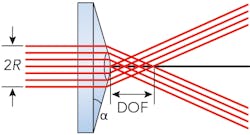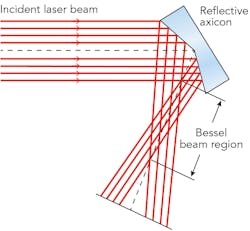Shaping ultrafast laser beams for glass processing
Efficient, accurate, and affordable laser-based glass processing techniques are becoming increasingly popular, especially for manufacturing display screens.1 Converting a laser to a Bessel beam profile aids in improving the efficiency and quality in laser glass processing. Bessel beams exhibit little to no diffraction while maintaining a tight focus over a relatively long depth of focus (DOF), much longer than standard Gaussian beams, allowing for sharp edges of features and minimal thermal effects to surrounding areas. Ultrafast laser sources are often utilized to maximize power and precision when cutting glass, but conventional transmissive axicons for Bessel beam generation may not be compatible with these ultrafast sources because of high levels of chromatic and group velocity dispersion, oscillations in the beam profile, and lack of stability. Reflective axicons are ideal for shaping ultrafast lasers into high-power, high-efficiency Bessel beams for glass processing.
Benefits of Bessel beams
All Gaussian beams have some level of divergence, increasing the beam diameter as the distance propagated increases. This varying beam diameter is detrimental in glass processing and other high-precision applications, limiting accuracy and reducing the predictability of results.
Bessel beams are formed by interference along a laser beam, featuring an intense concentration of energy propagating without diffraction. In fact, the diameter of Bessel beams may be even smaller than the diffraction limit. A true diffraction-free Bessel beam would require an infinite amount of energy to create, but axicons generate a close approximation with nearly non-diffracting properties along a given DOF.
While several different techniques are employed in glass processing, stealth dicing is widely considered to have the highest cutting efficiency.2 In stealth dicing, a laser beam is scanned along the intended cutting lines while drilling precise channels. A mechanical force is then applied to propagate a controlled fracture in the desired shape. Ultrafast laser sources allow for high drilling rates up to several hundred thousand channels per second.
To make clean cuts, the repeatability and precision of the drilled channels are essential. The diffraction of Gaussian beams is detrimental for both of these parameters. A mismatch in the focal position of multiple Gaussian beams will lead to differences in the channels formed, as diffraction will occur outside of their limited DOF. Bessel beams, on the other hand, are relatively immune to the impact of differences in focal position because of their consistent focus over a given region. They allow for finer control over channel shape and position. The DOF of Bessel beams might be 100X higher than standard Gaussian beams.
Where traditional axicons fall short
Traditional axicons are conical prisms that form a focal line along its optical axis. Incident light transmits through the axicon, focuses into a region with nearly no diffraction, and then continues propagating in a ring-shaped distribution (FIGURE 1).
While a near-Bessel beam is formed along the DOF, traditional axicons are not well suited for use with ultrafast laser sources. Because of the Heisenberg uncertainty principle, transform-limited laser pulses approaching their lower limit for pulse duration have a considerably wide wavelength spread. Ultrafast laser pulses have incredibly short pulse durations on the order of picoseconds, femtoseconds, or even attoseconds. The correspondingly broad bandwidth of ultrafast pulses leads to a significant amount of chromatic dispersion when transmitting through optical media, including traditional axicons. Most optical materials are characterized by positive dispersion, so long wavelengths will experience a phase velocity higher than that of shorter wavelengths. Ultrafast pulse duration is then elongated and the benefits of using an ultrafast source are reduced. Moreover, local optical index changes may occur in transparent axicons due to the high energy in the laser beam, making the Bessel pattern unstable and therefore unsuitable for use in an industrial setup such as a galvo scanner.
Spatial light modulators (SLMs), which use holograms, liquid-crystal cells, or other methods to modulate the phase of light, can also be used to generate Bessel beams. However, they typically have low energy efficiencies and cannot handle high laser powers. Ultrafast lasers exhibit high peak powers, making SLMs also not optimal solutions for ultrafast laser glass processing. Besides, the quality of the generated Bessel beam is limited by the number of pixels of the SLM and the generated beam is not very stable. Also, SLMs are comparatively expensive. All of these parameters make SLMs less suitable for an industrial use than other solutions.The solution: reflective axicons
Off-axis reflective axicons avoid the pitfalls of traditional axicons and generate high-quality Bessel beams that are closer to an ideal Bessel profile. Their manufacturing process allows for a sharper tip compared to a transmissive axicon. When the center of a beam goes through a rounded axicon tip, it generates a spherical phase beam that interferes with the Bessel beam generated by the conical part of the axicon. This creates oscillations within the profile and intensity fluctuations across the ablation threshold along the Bessel beam, leading to imprecise cuts. This does not occur with reflective axicons, thanks to their sharper apex (FIGURE 2).Finally, reflective axicons generate the most stable Bessel beams, which can even propagate through a galvo scanner.4 This paves the way to faster processes and use at an industrial scale.
The incorporation of ultrafast lasers into glass processing has greatly advanced the field, allowing for precise shaping of fragile materials while minimizing thermal effects and maximizing efficiency. Reflective axicons let system integrators take full advantage of ultrafast laser sources, minimizing chromatic dispersion and maintaining short pulse durations while creating repeatable features with Bessel beams.
REFERENCES
1. G. Overton, A. Nogee, D. Belforte, and C. Holton, “Annual Laser Market Review & Forecast: Where have all the lasers gone?” Laser Focus World, 53, 1, 32–52 (Jan. 2017).
2. R. Meyer, “Beam shaping aids transparent materials processing [editorial],” The Laser User, 84, 28–29 (2017).
3. J. Del Hoyo et al., Proc. SPIE, 10906, 1090605 (2019); https://doi.org/10.1117/12.2511295.
4. A. Billaud et al., Proc. SPIE, 11267, 112670C (2020); https://doi.org/10.1117/12.2545860.
About the Author
Cory Boone
Cory Boone is technical marketing manager at Edmund Optics. He is responsible for managing the creation of technical marketing content, including application notes, published articles, web copy, email campaigns, video scripts, trade show materials, case studies, and other marketing literature. He plans the company’s technical content strategy and acts as the technical voice of the marketing department. Cory is also active in educational outreach and spreading general awareness of the optics industry. He received a B.S. in Optical Sciences and Engineering along with minors in Math and Material Science Engineering from the University of Arizona.
Dr. Pu Jian
VP of Product Management & Partnerships, Cailabs
Dr. Pu Jian is VP of Product Management & Partnerships at Cailabs (Rennes, France).




